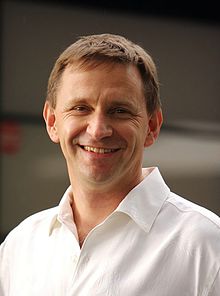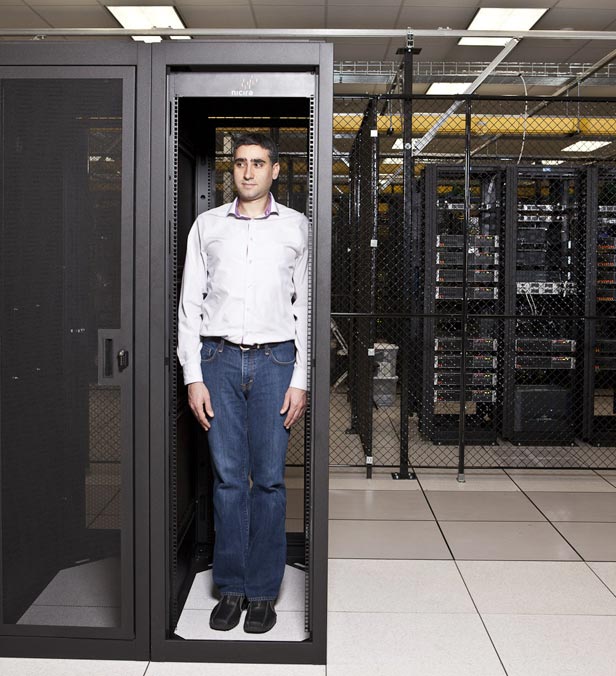How much does an SDN cost?
A billion dollars in cash - that's exactly how much VMware is willing to pay for one of the “hottest” Silicon Valley startups - Nicira . The total transaction amount will be $ 1.26 billion. Nicira billionaire startup was created by three university teachers less than 5 years ago. Nicira is a pioneer in the field of software-defined networks (PCN, in English - software defined networks, SDN).

It looks like a billion in cash - just for the sake of illustration
Nicira was founded in 2007 by three university professors: Martin Casado and Nick McKeown (Stanford University) and Scott Shenker from Berkeley, one of the first who have begun the development of PKS technology.

Martin Casado

Nick McKinnon

Scott Schenker
The very concept of a new network architecture, which later became known as software-configurable networks, emerged from Martin Casado’s doctoral dissertation in 2006. Kasado and McKone realized that modern network architecture was outdated and most likely would not be able to cope with growing requests in the near future. the industry is up to standard. Naturally, they were far from the first in this field. There have been many attempts to change the existing network architecture: it’s enough to recall the technology developed by Cisco — label-based switching, which was implemented in the MPLS protocol. Or Planet Lab - an international research project to develop new network services.
Unfortunately, making fundamental changes to network equipment and protocols was very difficult and impossible without the involvement of the manufacturer. Networking tools today are proprietary, closed to changes by network owners and the scientific community. Almost always, the transition from the equipment of one vendor to the equipment of another is a big headache and the cost of huge financial resources.
In this situation, the idea of McKone, Casado, and Schenker very successfully "shot": they proposed to separate the level of control and data transfer. In modern networks, these functions are combined, which makes monitoring and control very difficult. The researchers suggested that if the switches “take over” the management of the switching tables, then it would be possible to arbitrarily control the behavior and speed characteristics of the individual switch and the parameters of the transmitted data flows across all Ethernet networks. Casado proposed to solve the problem of dependence on equipment of one vendor using the new OpenFlow network protocol. It is generally worth talking about him separately.
The main idea of the PKS approach is to:
The proposed concept was extremely favorably accepted by the scientific community. Next, a joint research center, Open Networking Research Center , was created , in the laboratory of which research on the subject of PKS was continued. All research programs of the center are open, the software within the framework of the PKS approach is Open Source.
At the same time, these Cassado, McKinnon and Schenker are creating a commercial project, Nicira, which was to engage in the implementation of a new approach in the field of network virtualization. Nicira began to actively create their own platform in the field of network virtualization - network virtualization platform (NPV).

The scheme of the platform.
NVP acts as a thin software layer at the edge of the network and is managed by distributed clusters of controllers. It allows you to dynamically, without changing addresses and disrupting the workflow, create virtual networks endowed with all the properties and services of real analogues, supporting the mobility of virtual machines both inside and between the data center. Independence from the equipment provides full hardware cross-platform and makes it possible for the virtual network to function stably even when the equipment is being upgraded.
A little later, Nicira also developed the Distributed Virtual Network Infrastructure (DVNI), which allows you to create a distributed virtual network infrastructure in the cloud data centers that is completely abstracted from the physical network equipment.
According to Nicira Executive Director Stephen Mullaney, the results of the operation of the new platform in the data center of the largest cloud service operators show that without network virtualization, 20-30% of the server data center resources remain idle, and costs increase several times. In a very short time Nicira was able to get to the customers of the largest providers in the USA: AT&T, NTT. Nicira's customers also include giants such as eBay, DreamHost, Fidelity Investments, and Rackspace. In 2010, Nicira hit 25 promising startups .
Since 2009, Nicira has gone through 3 rounds of investments totaling about $ 50 million. In February 2012, venture funds Andreessen Horowitz, Lightspeed Venture Partners and New Enterprise Associates, Diane Greene, co-founder, invested in the company in the third round VMware and Andy Rachleff, Benchmark Capital. And just six months later, VMware announced their intention to buy Nicira for $ 1.26 billion. This is the first major transaction that showed that now we can talk about a separate market for PKS solutions.

One Martin Cassado replaces an entire server rack
The main outcome of the story: 3 teachers and private investors in just a few years were able to build a company worth $ 1 billion, which changed the approach to virtualization and in the near future will change the balance of power in the virtualization and network solutions market. Journalists and experts are seriously asking whether software-configured networks can “kill” market giants such as Cisco, Juniper, IBM, Brocade, and can this deal be considered the beginning of the Cold War between VMware and Cisco ?
Meanwhile, Andressen Horowitz announces that in a few years the PCS solutions market will be around $ 40-50 billion, to investors who managed to make $ 1.26 billion from $ 50 million in half a year. I think you can believe.
PS
In kamenty to the post promised everizhnikovafrom the Center for Applied Research on Computer Networks , it’s awful, let's flood it with questions about how to move the development of PCS with us.

It looks like a billion in cash - just for the sake of illustration
Nicira was founded in 2007 by three university professors: Martin Casado and Nick McKeown (Stanford University) and Scott Shenker from Berkeley, one of the first who have begun the development of PKS technology.

Martin Casado

Nick McKinnon

Scott Schenker
The very concept of a new network architecture, which later became known as software-configurable networks, emerged from Martin Casado’s doctoral dissertation in 2006. Kasado and McKone realized that modern network architecture was outdated and most likely would not be able to cope with growing requests in the near future. the industry is up to standard. Naturally, they were far from the first in this field. There have been many attempts to change the existing network architecture: it’s enough to recall the technology developed by Cisco — label-based switching, which was implemented in the MPLS protocol. Or Planet Lab - an international research project to develop new network services.
Unfortunately, making fundamental changes to network equipment and protocols was very difficult and impossible without the involvement of the manufacturer. Networking tools today are proprietary, closed to changes by network owners and the scientific community. Almost always, the transition from the equipment of one vendor to the equipment of another is a big headache and the cost of huge financial resources.
In this situation, the idea of McKone, Casado, and Schenker very successfully "shot": they proposed to separate the level of control and data transfer. In modern networks, these functions are combined, which makes monitoring and control very difficult. The researchers suggested that if the switches “take over” the management of the switching tables, then it would be possible to arbitrarily control the behavior and speed characteristics of the individual switch and the parameters of the transmitted data flows across all Ethernet networks. Casado proposed to solve the problem of dependence on equipment of one vendor using the new OpenFlow network protocol. It is generally worth talking about him separately.
The main idea of the PKS approach is to:
- Separate network equipment management from data transfer control by creating special software that can run on a regular separate computer and which is controlled by the network administrator.
- Go from managing individual instances of network equipment to managing the network as a whole.
- Create an intelligent, software-driven interface between the network application and the network transport medium.
The proposed concept was extremely favorably accepted by the scientific community. Next, a joint research center, Open Networking Research Center , was created , in the laboratory of which research on the subject of PKS was continued. All research programs of the center are open, the software within the framework of the PKS approach is Open Source.
At the same time, these Cassado, McKinnon and Schenker are creating a commercial project, Nicira, which was to engage in the implementation of a new approach in the field of network virtualization. Nicira began to actively create their own platform in the field of network virtualization - network virtualization platform (NPV).

The scheme of the platform.
NVP acts as a thin software layer at the edge of the network and is managed by distributed clusters of controllers. It allows you to dynamically, without changing addresses and disrupting the workflow, create virtual networks endowed with all the properties and services of real analogues, supporting the mobility of virtual machines both inside and between the data center. Independence from the equipment provides full hardware cross-platform and makes it possible for the virtual network to function stably even when the equipment is being upgraded.
A little later, Nicira also developed the Distributed Virtual Network Infrastructure (DVNI), which allows you to create a distributed virtual network infrastructure in the cloud data centers that is completely abstracted from the physical network equipment.
According to Nicira Executive Director Stephen Mullaney, the results of the operation of the new platform in the data center of the largest cloud service operators show that without network virtualization, 20-30% of the server data center resources remain idle, and costs increase several times. In a very short time Nicira was able to get to the customers of the largest providers in the USA: AT&T, NTT. Nicira's customers also include giants such as eBay, DreamHost, Fidelity Investments, and Rackspace. In 2010, Nicira hit 25 promising startups .
Since 2009, Nicira has gone through 3 rounds of investments totaling about $ 50 million. In February 2012, venture funds Andreessen Horowitz, Lightspeed Venture Partners and New Enterprise Associates, Diane Greene, co-founder, invested in the company in the third round VMware and Andy Rachleff, Benchmark Capital. And just six months later, VMware announced their intention to buy Nicira for $ 1.26 billion. This is the first major transaction that showed that now we can talk about a separate market for PKS solutions.

One Martin Cassado replaces an entire server rack
The main outcome of the story: 3 teachers and private investors in just a few years were able to build a company worth $ 1 billion, which changed the approach to virtualization and in the near future will change the balance of power in the virtualization and network solutions market. Journalists and experts are seriously asking whether software-configured networks can “kill” market giants such as Cisco, Juniper, IBM, Brocade, and can this deal be considered the beginning of the Cold War between VMware and Cisco ?
Meanwhile, Andressen Horowitz announces that in a few years the PCS solutions market will be around $ 40-50 billion, to investors who managed to make $ 1.26 billion from $ 50 million in half a year. I think you can believe.
PS
In kamenty to the post promised everizhnikovafrom the Center for Applied Research on Computer Networks , it’s awful, let's flood it with questions about how to move the development of PCS with us.
